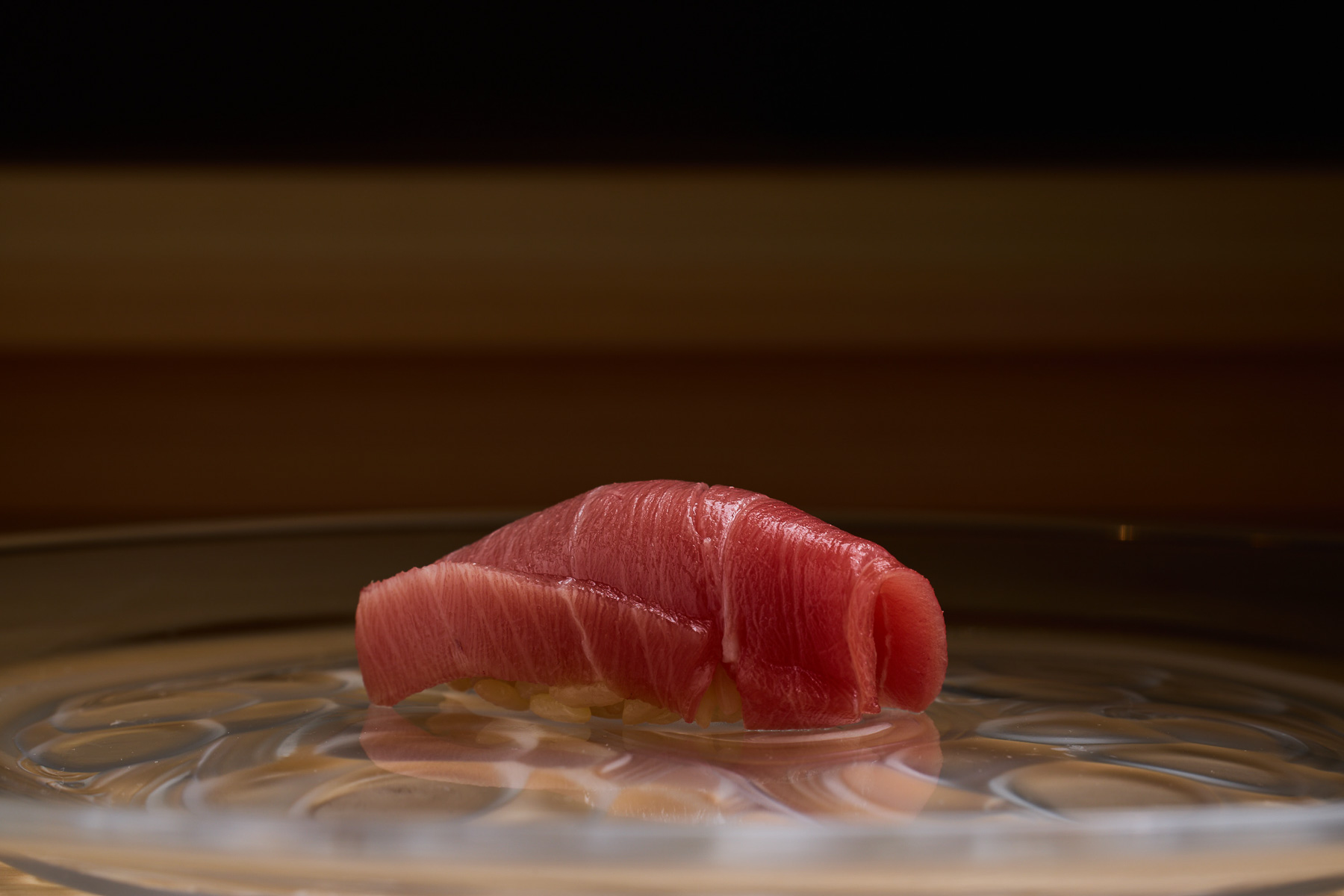
Kyoto
Gion Sushi Takamitsu
祇園 鮨 尚充
An authentic Edomae sushi experience in the heart of Gion. Located on Kyoto’s atmospheric Hanamikoji Street, Gion Takamitsu made its much-anticipated debut in 2025. This elegant newcomer is an offshoot of Tokyo’s Sushi Takamitsu, a restaurant so acclaimed that securing a reservation borders on the impossible. Using the highest-quality fish delivered daily from Toyosu, Chef Jun Kamekawa’s devotion to his craft shapes the restaurant’s spirit as much as its exquisite cuisine.
Just steps from the Gion Kobu Kaburenjo Theater, where maiko perform the springtime Miyako dance, the restaurant sits in the heart of a district that cherishes Kyoto’s timeless traditions. The graceful entrance features plain wooden lattice doors and a linen noren curtain. The refined and spacious interior evokes a traditional Noh stage, with a bamboo-lined ceiling hovering over earthen walls. Just beside the pristine Bishu cypress counter lies a small, glass-enclosed garden.
At the helm is Chef Jun Kamekawa, a craftsman who refined his technique over 12 years at Sushi Takamitsu. His approach mirrors that of the Tokyo flagship, where the day’s menu is dictated by the best seasonal ingredients available from trusted fish dealers. His sourcing speaks not just to excellence in quality, but to deep-rooted relationships cultivated over years.
"It all comes down to which vendors we work with,” he explains. “For tuna, we go through Yamayuki, the top wholesaler at Toyosu. Our uni comes from Hadate Suisan in Hokkaido. They consistently provide the finest quality available.”
Kamekawa’s omakase unfolds with a deliberate rhythm: alternating courses of nigiri and small plates, ten of each. Guests are treated to lean, medium fatty, otoro and fatty tuna with caviar, each course presenting its own unique flavor. Two varieties of sea urchin are offered, often a combination of red and purple.
The sushi rice is prepared in several batches, its temperature and seasoning adjusted carefully for each ingredient. Compared to Sushi Takamitsu, the rice here is slightly less salty to suit Kyoto’s delicate palate. Seasoned with red and rice vinegars, it is, as the chef describes, “small, but with a punch that lingers.” His aim, always, is to achieve perfect harmony between shari and neta—rice and topping.
The tableware also reflects the restaurant’s refined sensibility. A luminous Lalique glass plate is used for palate cleansers, while dishes for grilled and simmered items arrive in exquisite antique porcelain. At the end of the meal, a thoughtful gesture awaits: a bright blue box containing wooden chopsticks, a parting gift that extends the restaurant’s hospitality beyond its walls.
CUISINE
An exquisite alternation of nigiri sushi and seasonal small plates
Gion Takamitsu’s omakase showcases an exquisite alternation of nigiri sushi and seasonal small plates. The sequencing creates a beautiful rhythm, each piece arriving at just the right moment to draw the diner deeper into a seasonally attuned experience.
The sushi, prepared with fish delivered directly from Toyosu Market, represents the finest of what Japan’s waters yield. Highlights include supple squid, cured Spanish mackerel and the buttery richness of yellowtail. Ark shell is served with its characteristic briny snap, while horse mackerel and gizzard shad bring a bright, silvery freshness. The Hadate purple sea urchin from Hokkaido is firm, creamy and deeply rich. In contrast, the Nozomi bafun uni offers a melting texture and fresh taste of the ocean.
The tuna courses are served in a progression through four different cuts, each sourced from premier regions such as Oma in Aomori, Katsuura in Chiba and Hazaki in Ibaraki. The chutoro, with its divine marbling, offers a luxurious mouthfeel, while the lean cut highlights the pure flavor of the fish. A standout is the fatty tuna and caviar gunkanmaki. The pounded otoro and pickled radish are enveloped in nori and topped with caviar, creating a sublime combination of rich flavors.
The seasonal small plates are prepared with the same elegance as the nigiri courses. Salt-grilled blackthroat seaperch, served with mountain wasabi, arrives with crackling skin and tender flesh, plated on antique blue-and-white porcelain that elevates the presentation. Other dishes include sashimi, vinegared preparations, steamed abalone, kombu with roe and Kyoto-style pickles such as bettara-zuke.
INGREDIENTS
Every ingredient is sourced with careful precision, relying on the same Toyosu Market wholesalers as the Tokyo main store.
“The trust we’ve built is what allows us to secure top-tier fish year-round,” the chef says. “The stability of high-quality purchases may be what makes a sushi restaurant a success.”
As for vegetables, he plans to buy more local vegetables from Kyoto that go well with the cuisine. The restaurant also serves a wide selection of beer, sake, shochu, champagne and wine, with some 4,000 bottles stored in the restaurant’s cellars.


CHEF
Jun Kamekawa
SEA URCHIN
Sea urchin holds a special place in Kamekawa’s repertoire. Arriving from Hokkaido in decorative wooden boxes, these uni are as visually striking as they are flavorful—each piece glistening like a jewel. The Nozomi sea urchin, a premium bafun uni, is loved for its seaweed-like aroma, silky texture, and uniform golden beauty. The Hadate purple sea urchin has a firm structure and rich, briny depth. Despite their scarcity, the batches are delivered reliably from a trusted Toyosu wholesaler, thanks to a relationship built over the years.
Course
- The price includes our booking fee of ¥8,000
- The price includes our booking fee of ¥8,000












